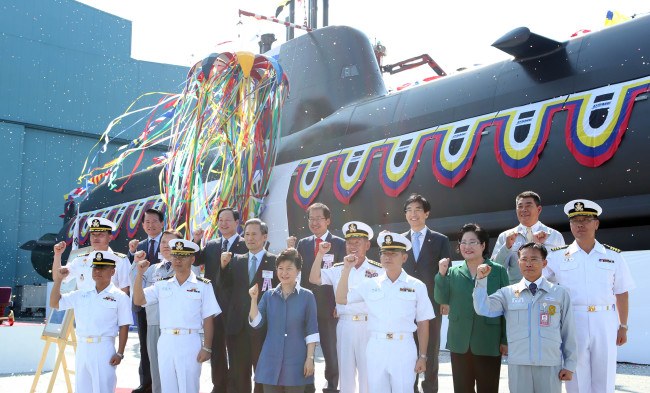South Korea on Tuesday unveiled its fourth 1,800-ton submarine, which is to be a core naval asset to defend against North Korean provocations and neighboring states’ growing maritime ambitions.
The launch ceremony for the vessel, named after Gen. Kim Jwa-jin, an admired 1920s independence fighter, was held at a shipyard of Daewoo Shipbuilding & Marine Engineering Co. on Geojedo Island, South Gyeongsang Province.
President Park Geun-hye became the first head of state to cut the tape to launch the “214-class” submarine. Traditionally, women such as first ladies or wives of top commanders have cut the tape during launch ceremonies for naval vessels.
“The Kim Jwa-jin submarine will not only contribute greatly to safeguarding our maritime sovereignty, but also become a symbol to promote our country’s defense science and technology,” she said during the ceremony.
“I will not tolerate any kind of attempts at damaging our national interests and maritime sovereignty.”
The high-profile event was attended by Defense Minister Kim Kwan-jin, heads of the three armed services and Rep. Yoo Seong-min of the ruling Saenuri Party, who chairs the National Assembly’s national defense committee.
The launch ceremony for the vessel, named after Gen. Kim Jwa-jin, an admired 1920s independence fighter, was held at a shipyard of Daewoo Shipbuilding & Marine Engineering Co. on Geojedo Island, South Gyeongsang Province.
President Park Geun-hye became the first head of state to cut the tape to launch the “214-class” submarine. Traditionally, women such as first ladies or wives of top commanders have cut the tape during launch ceremonies for naval vessels.
“The Kim Jwa-jin submarine will not only contribute greatly to safeguarding our maritime sovereignty, but also become a symbol to promote our country’s defense science and technology,” she said during the ceremony.
“I will not tolerate any kind of attempts at damaging our national interests and maritime sovereignty.”
The high-profile event was attended by Defense Minister Kim Kwan-jin, heads of the three armed services and Rep. Yoo Seong-min of the ruling Saenuri Party, who chairs the National Assembly’s national defense committee.

Measuring 65.3 meters long and 6.3 meters wide, the submarine features state-of-the art weapons systems including the “air independent propulsion system” that enables the vessel to conduct underwater operations for two weeks without emerging.
The multi-role submarine, which has a top speed of 37 kilometers per hour, is capable of handling 300 targets at the same time. It is designed to carry out missions to strike ships, aircraft and submarines. It can carry 40 sailors.
The Kim Jwa-jin submarine will be delivered to the Navy in the latter half of next year after an operational evaluation. Following a set of tests, it is expected to go into service in 2015.
By 2018, the military plans to introduce five more 214-class submarines. Along with these vessels, the Navy also runs nine 1,200-ton 209-class submarines, which were commissioned from the early 1990s and will be phased out in the 2020s.
Apart from the 1,800-ton submarine, the Navy is working on developing 3,000-ton submarines equipped with vertical launchers to fire long-range precision submarine-to-ground missiles. Between 2020 and 2030, the Navy will push to secure nine such submarines. The Navy plans to operate a total of 20 submarines after 2020.
The military has been bolstering its anti-submarine capabilities since March 2010 when a North Korean midget submarine torpedoed the South Korean corvette Cheonan near the western sea border, killing 46 sailors.
The communist state outnumbers its southern neighbor with its submarine fleet, though it is old and equipped with outdated weapons. The North is believed to have some 70 submarines including some 20 1,800-ton Romeo-class submarines and about 40 325-ton Sangeo-class submarines.
To bolster anti-submarine capabilities, the Navy plans to secure 20 additional maritime surveillance aircraft from 2018. It currently has 16 P-3C aircraft, but experts say they are not sufficient to maintain water-tight maritime security.
Maritime security has been increasingly crucial for the South Korean military not just because of North Korea, but also as neighboring states vie to bolster their own fleets.
China has a long-term, consistent maritime operational strategy that covers not only the South and East China seas, but also virtually the entire world by 2050. Its first aircraft carrier Liaoning is now in service. Beijing plans to build more carriers.
Japan has also sought to make its maritime strategy more active to cover broader-range operations apparently to keep China in check and secure its maritime interests.
By Song Sang-ho (sshluck@heraldcorp.com)
-
Articles by Korea Herald




![[Herald Interview] 'Amid aging population, Korea to invite more young professionals from overseas'](http://res.heraldm.com/phpwas/restmb_idxmake.php?idx=644&simg=/content/image/2024/04/24/20240424050844_0.jpg&u=20240424200058)












![[KH Explains] Korean shipbuilding stocks rally: Real growth or bubble?](http://res.heraldm.com/phpwas/restmb_idxmake.php?idx=652&simg=/content/image/2024/04/25/20240425050656_0.jpg&u=)

